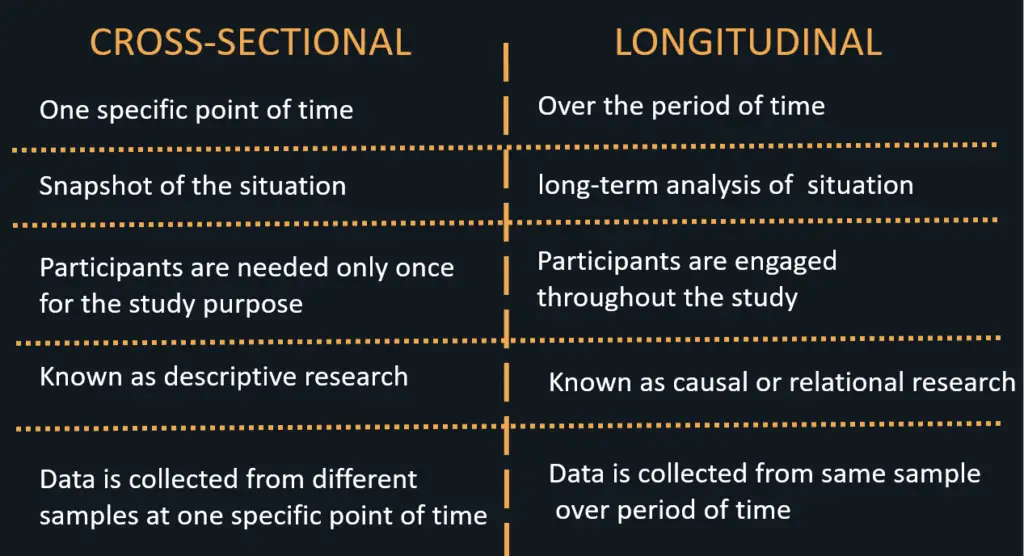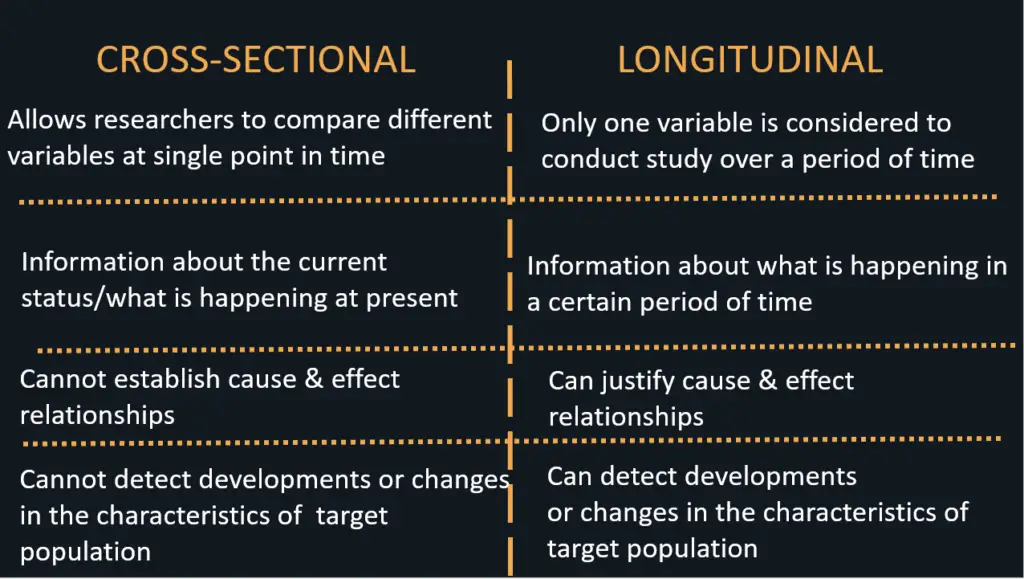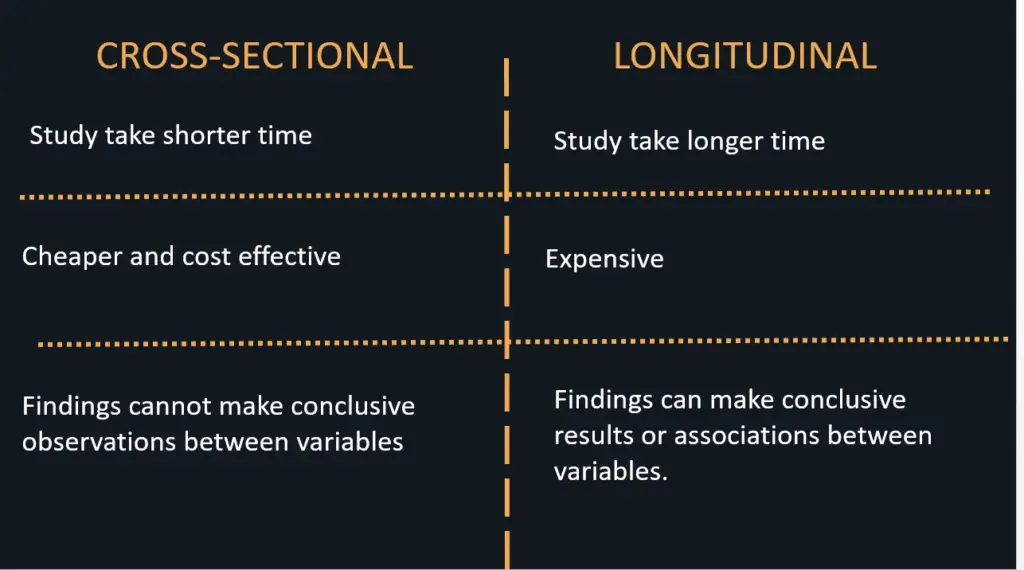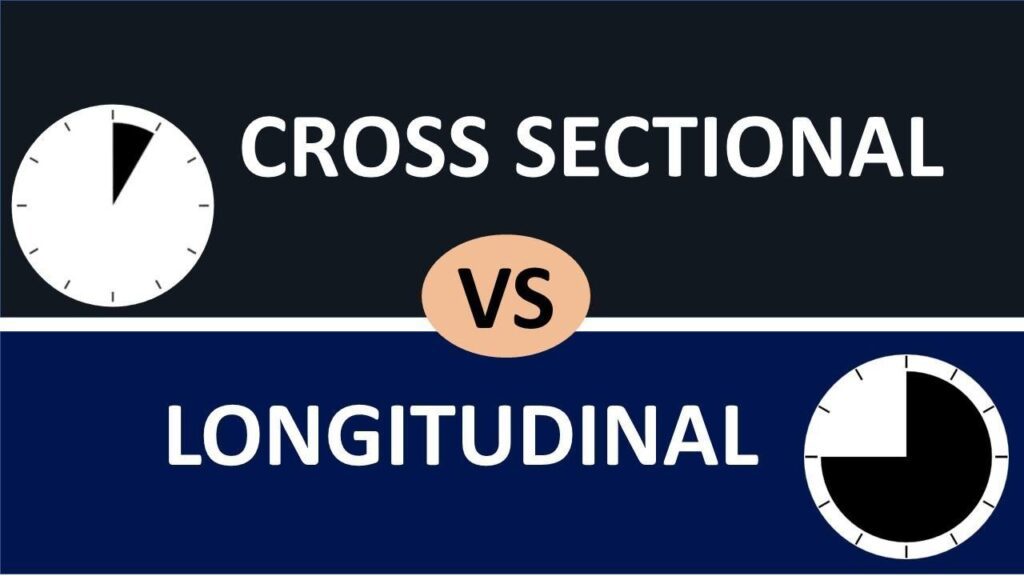Cross-sectional studies look at individuals or groups of people in relation to their current state. Cross-sectional studies are often used to identify the association between variables such as risk factors and health outcomes. In this article, we’ll explain cross-sectional vs longitudinal studies and the key differences
They can be useful for understanding the relationships between different variables that could potentially influence a particular outcome. Longitudinal studies follow participants over time, following them from their first meeting until they have left the study or reached some sort of endpoint.
Longitudinal studies are much more complex than cross-sectional studies but are also much more useful in understanding how changes over time affect individual outcomes and whether interventions work.
What is a Cross-sectional Study?
A cross-sectional study is a research method used to investigate relationships between different variables at a specific point in time. A cross-sectional study can help answer questions such as
“What is the prevalence of a particular disease in a population?”
“What is the relationship between symptoms and disease?”
Cross-sectional studies are often used to identify the association between variables such as risk factors and health outcomes. A cross-sectional study is a single snapshot in time. It is often used to examine relationships between variables such as risk factors and health outcomes.
Cross-sectional studies can help researchers determine the prevalence of a disease or the percentage of a population that displays a particular characteristic. Cross-sectional studies are also useful for exploring relationships between variables that could potentially influence a particular outcome.
This is the study that can be undertaken in which data are gathered just once, perhaps over a period of days or weeks, or months, in order to answer a research question. Such studies are called one‐shot or cross‐sectional studies. The purpose of the studies was to collect data that would be pertinent to finding the answer to a research question.
Cross-sectional studies may be descriptive or analytical.
Descriptive cross-sectional studies are aimed at describing a situation or an outcome based on the current state. An analytical cross-sectional study is used to test hypotheses or relationships.
Example:

1- Data were collected from stock brokers between April and June of last year to study their concerns in a turbulent stock market. Data with respect to this particular research had not been collected before, nor will they be collected again for this research.
2- A drug company wanting to invest in research for new obesity (reduction) pills conducted a survey among obese patients to gauge interest in the new medication among them. This is one‐shot or cross‐sectional. This study assesses the likely demand for the new product.

What is a Longitudinal Study?
A longitudinal study is a research method in which data are collected from a sample of participants over a specified period of time. The researchers will follow the same sample throughout the study, collecting data from each individual at regular intervals.
A longitudinal study can help answer questions such as
“What happens to people as they go through the course of their lives?”
“Does a particular intervention work?”
Longitudinal studies are often used to understand how changes over time affect individual outcomes and whether interventions work. A longitudinal study is a series of observations made on the same group of people over a period of time.
Longitudinal studies are often used to understand how changes over time affect individual outcomes and whether interventions work.
Research using a longitudinal design can help us understand how changes in a person’s health, behavior, or other outcomes over time are related to changes in the person’s situation or environment.
This is a research design in which the researcher studies people or phenomena at more than one point in time in order to answer the research question. Data on the dependent variables are gathered at two or more points in time to answer the research question.
It helps to identify cause‐and‐effect relationships Longitudinal studies are often more complex than cross-sectional studies, but they are also much more useful in understanding how changes over time affect individual outcomes and whether interventions work.
Example:

1- The researcher might want to study employees’ behavior before and after a change in the top management, so as to know what effects the change accomplished.
2- A marketing manager is interested in tracking the quarterly sales trends of a specific product over the course of the next two years in four distinct regions of the nation. The study fits into the category of longitudinal research since data will be gathered throughout time to address the same question (tracing sales history).

Key Differences:

- Cross-sectional studies are carried out at one specific point in time whereas longitudinal studies are carried out over a period of time.
- Cross-sectional studies provide a snapshot of the situation whereas longitudinal studies provide a long-term analysis of the situation.
- In a cross-sectional study, participants are needed only once for the study purpose. In the longitudinal study, participants are engaged throughout the study.
- Cross-sectional study is known as descriptive research whereas a longitudinal study is known as causal or relational research. In Cross-sectional studies, data is collected from different samples at one specific point in time whereas, in longitudinal studies, Data is collected from the same sample over a period of time.

- The advantage of cross-sectional research design is that it allows researchers to compare different variables (age, sex, gender, income, etc.) at a single point in time whereas, in longitudinal research design, one variable is considered to conduct the study over a period of time.
- Cross-sectional studies provide information about the current status/what is happening at present whereas longitudinal studies provide information about what is happening in a certain period of time.
- Cross-sectional studies do not provide information and cannot establish cause and effect relationships whereas longitudinal studies can establish and justify cause and effect relationships.
- Researchers are not able to detect developments or changes in the characteristics of the target population in Cross-sectional studies. On the contrary, Researchers are able to detect developments or changes in the characteristics of the target population at both the group and the individual level in longitudinal studies.

- Cross-sectional studies take a relatively shorter time than longitudinal studies
- Economically, cross-sectional studies are cheaper and cost-effective compared to longitudinal studies.
- Findings from cross-sectional studies aren’t enough to make conclusive observations about any association/significance between variables whereas Findings from longitudinal studies could be used to make conclusive results or associations between variables.
When to Use a Cross-sectional Study
A cross-sectional study is appropriate to identify relationships between variables and compare frequencies in a given population at one specific point in time.
Longitudinal studies, on the other hand, are used to examine the change of an outcome over time and help us understand how changes over time affect individual outcomes.
Cross-sectional studies are often used to identify the association between variables such as risk factors and health outcomes.
For example, a study might compare the prevalence of certain diseases in different regions of the world.
In this type of study, researchers will collect data from individuals in the different regions at one point in time. Therefore, they are using a cross-sectional study design.
When to Use a longitudinal Study
A longitudinal study design is appropriate to examine the change of an outcome over time and help us understand how changes over time affect individual outcomes.
Longitudinal studies can help us understand how changes in a person’s health, behavior, or other outcomes over time are related to changes in the person’s situation or environment.
For example, a study might follow individuals over time to examine how their health changes over the course of their lives. In this type of study, researchers will collect data from the same individuals at regular intervals to understand how their health changes over time. Therefore, they are using a longitudinal study design.
Conclusion
A cross-sectional study is a single snapshot in time, whereas a longitudinal study follows the same individuals over time. Cross-sectional studies are often used to identify the association between variables such as risk factors and health outcomes. They can also be used to compare frequencies in a given population at one specific point in time.
Longitudinal studies, on the other hand, are used to examine the change of an outcome over time and help us understand how changes over time affect individual outcomes. When you are trying to answer research questions, you’ll need to decide whether to use a cross-sectional or longitudinal study design.
These two types of studies have different strengths and weaknesses and are best used in different situations. A cross-sectional study can help you understand what is happening in a population at one point in time, while a longitudinal study can help you understand how changes over time affect individual outcomes.
Other articles
Please read through some of our other articles with examples and explanations if you’d like to learn more about research methodology.
Comparision
- Basic and Applied Research
- Cross-Sectional vs Longitudinal Studies
- Survey vs Questionnaire
- Open Ended vs Closed Ended Questions
- Experimental and Non-Experimental Research
- Inductive vs Deductive Approach
- Null and Alternative Hypothesis
- Reliability vs Validity
- Population vs Sample
- Conceptual Framework and Theoretical Framework
- Bibliography and Reference
- Stratified vs Cluster Sampling
- Sampling Error vs Sampling Bias
- Internal Validity vs External Validity
- Full-Scale, Laboratory-Scale and Pilot-Scale Studies
- Plagiarism and Paraphrasing
- Research Methodology Vs. Research Method
- Mediator and Moderator
- Type I vs Type II error
- Descriptive and Inferential Statistics
- Microsoft Excel and SPSS
- Parametric and Non-Parametric Test
Comparision
- Independent vs. Dependent Variable – MIM Learnovate
- Research Article and Research Paper
- Proposition and Hypothesis
- Principal Component Analysis and Partial Least Squares
- Academic Research vs Industry Research
- Clinical Research vs Lab Research
- Research Lab and Hospital Lab
- Thesis Statement and Research Question
- Quantitative Researchers vs. Quantitative Traders
- Premise, Hypothesis and Supposition
- Survey Vs Experiment
- Hypothesis and Theory
- Independent vs. Dependent Variable
- APA vs. MLA
- Ghost Authorship vs. Gift Authorship
Research
- Research Methods
- Quantitative Research
- Qualitative Research
- Case Study Research
- Survey Research
- Conclusive Research
- Descriptive Research
- Cross-Sectional Research
- Theoretical Framework
- Conceptual Framework
- Triangulation
- Grounded Theory
- Quasi-Experimental Design
- Mixed Method
- Correlational Research
- Randomized Controlled Trial
- Stratified Sampling
- Ethnography
- Ghost Authorship
- Secondary Data Collection
- Primary Data Collection
- Ex-Post-Facto
Research
- Table of Contents
- Dissertation Topic
- Synopsis
- Thesis Statement
- Research Proposal
- Research Questions
- Research Problem
- Research Gap
- Types of Research Gaps
- Variables
- Operationalization of Variables
- Literature Review
- Research Hypothesis
- Questionnaire
- Abstract
- Validity
- Reliability
- Measurement of Scale
- Sampling Techniques
- Acknowledgements
Statistics




1 Comment
Excellent content. Thanks for sharing.